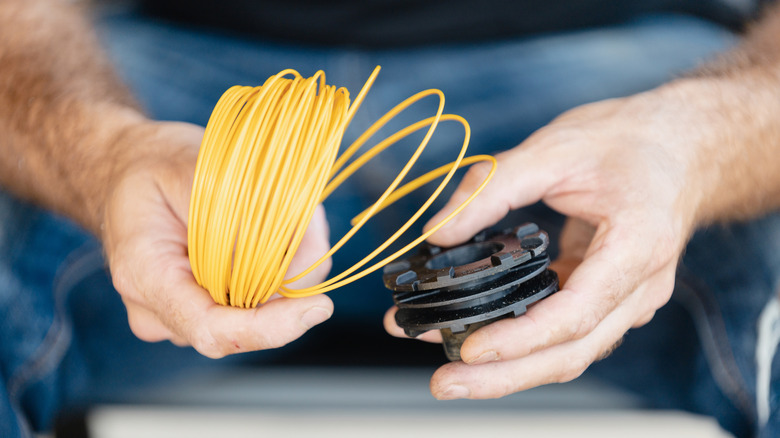How Often You Should Be Changing The Strings On Your Weed Whacker
In spite of the trimmer's position as one of many essential lawn tools for healthy lawns, dealing with string trimmer line is one of the most annoying — some would say loathsome — maintenance tasks in the whole lawn care universe. And possibly in the whole universe, full stop. The stuff seems to break without provocation, and the mechanisms for automatically feeding out new line are often unbelievably unreliable. As a result, the process of weed whacking looks more like standing in your yard staring at the trimmer's jammed head. But it's better than the alternatives and immensely better than certain viral TikTok weed eater hacks.
If you're wondering how often you should swap out your string trimmer line, you're lucky. For most of us, trimmer line changes itself pretty rapidly by constantly breaking. If you have line on your trimmer that makes it through an entire season, that's a bit of a miracle. The bottom line, for most people, is that you don't have to change it out at all. Just use it until it's gone, then reload. The timeframe for this depends largely on how much you use it and what type of material you're cutting with it.
The reason is that the material most string trimmer line is made from, nylon, is very well-suited to its task. It has high tensile strength and easily resists ordinary wear from impact and abrasion. It isn't affected by high temperatures and is often dyed to reduce its vulnerability to UV light. It usually holds up so well that what's on your trimmer won't need to be replaced until it runs out. If you have a storehouse of many spools of replacement line, on the other hand, you might want to consider swapping that out from time to time.
Knowing when to change your line ... and when you don't have to
String trimmer line stored in a climate-controlled space, or at least one that isn't subject to temperature extremes, will usually outlast your patience. Since UV radiation causes nylon to break down, avoid direct sunlight during storage. But even stored as poorly as possible (say, out in the middle of your sunny lawn), it's resilient. Once the line has become brittle or discolored — that is, once the dyes that protect it from UV light have faded — it's time to replace that spool. You may also need to change it if the line becomes frayed or worn down.
In most cases, though, there's a weedeater hack you can use to make the line last longer so you don't have to worry about line changes. The trick that rejuvenates your trimmer line almost completely is soaking (or even storing) your string trimmer line in water. That doesn't mean spritzing it lightly, although research shows that high humidity alone can do the trick. What we're talking about here is dunking the spool in a bucket of water and leaving it there for a few hours ... or forever. Soaking not only protects the line from heat, but it also changes the mechanical properties of the nylon in just the way you need.
Here's what's going on: Absorbed water acts as a plasticizer for nylon; it makes the material more flexible and less brittle. Water lowers the glass transition temperature. Below the glass transition temperature, nylon can be brittle and difficult to work with; above the newly lowered temperature (as low as 68 degrees Fahrenheit), the trimmer line is more flexible and resistant to breaking. So keep yourself and your trimmer line hydrated this summer to avoid unnecessary string trimmer line changes.

